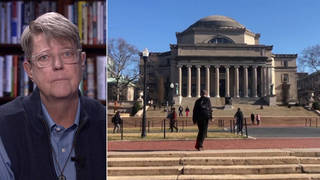
Guests
- Steve Shallhorncampaign director for Greenpeace Canada.
In Canada, environmental activists are protesting plans to import tons of U.S. and Russian plutonium waste for use in nuclear reactors. Canadian Prime Minister Jean Chrétien wrote a letter to President Clinton saying Canada is prepared to consider any safe and financially viable proposal to dispose of the radioactive waste from warheads and facilities in the U.S. and Russia. Much of the waste would come from Los Alamos in New Mexico, crossing the border into northern Ontario. Critics say the plan would expose Canada to a serious environmental risk. We’re joined by Steve Shallhorn, campaign director for Greenpeace Canada. [includes rush transcript]
Transcript
AMY GOODMAN: In Canada, environmental activists are protesting plans to import tons of U.S. and Russian plutonium waste for use in nuclear reactors. Canadian Prime Minister Jean Chrétien wrote a letter to President Clinton saying Canada is prepared to consider any safe and financially viable proposal to dispose of the radioactive waste from warheads and facilities in the U.S. and Russia. Much of the waste would come from Los Alamos in New Mexico, crossing the border into northern Ontario. Critics say the plan would expose Canada to a serious environmental risk.
At the same time this controversy is going on, in the United States NBC removed all references to nuclear waste in a made-for-TV blockbuster that aired over the last two nights called Atomic Train. In the fictional movie, a train hurtles out of control from Idaho to Denver and ultimately leads to an atomic explosion in Denver. And it was originally carrying nuclear waste, but after NBC objected, they changed the script and overdubbed, every time the term “nuclear waste” was used, “toxic waste.”
Well, that’s not what’s happening in Canada right now. People aren’t afraid to talk about nuclear waste. And we’re joined right now by Steve Shallhorn, who is campaign director for Greenpeace Canada.
Can you talk about the real, live protests that are going on in Canada?
STEVE SHALLHORN: Well, what we’re doing in Canada is the Canadian government is part of a scam to start burning plutonium in civil reactors, and there is a plan to do that in Canada and also in the United States. The plutonium is supposed to be coming from nuclear warheads that are being dismantled by the U.S. and Russian governments. We actually believe that while some of it may—some of the plutonium may be coming from older warheads, that there’s also lots of bits of scrap and bits and bobs of plutonium that they can’t really use, that are likely to be used up in this program. So, in effect, what it really is, is plutonium waste. And the government here in Canada is promoting it as a contribution to nuclear disarmament and as a cheap way to generate electricity, and it is neither.
AMY GOODMAN: Can you talk about how the plutonium would get to you?
STEVE SHALLHORN: The U.S. plutonium would be shipped by truck from Los Alamos nuclear labs to the experimental reactors in Chalk River, Ontario, by one of three possible routes. One would go up through Western states into the Dakotas and cross into Canada at Emerson, Manitoba, and then through Winnipeg and over the top of the Great Lakes to Chalk River, which is near the capital city of Ottawa. A second route would go up through Michigan and cross at Port Huron, Michigan, into Sarnia, Ontario, and along through Toronto. And the third possible route would be upstate New York crossing the Thousands Islands and then up to the Chalk River plant. Those—if one of those three routes has been selected, it’s being kept a secret.
AMY GOODMAN: And how exactly would the plutonium be transported?
STEVE SHALLHORN: Well, this first shipment is a relatively small amount of plutonium, less than a kilogram. And somewhat to our surprise, we found out that it’s sent by commercial carrier, commercial truck, with absolutely no security. And the reason for that is that international regulations only require security if the amount being transported is over a kilogram. It doesn’t make much sense to us, because the plutonium in the test shipment can be used in a nuclear warhead. It might not be enough for an entire warhead but certainly would be a good chunk of it. And to have absolutely no security on it and to send it by commercial carrier seems to be cavalier, to say the least.
AMY GOODMAN: We’re talking to Steve Shallhorn. He is the coordinator for Greenpeace Canada, speaking to us from Ontario about a shipment of plutonium planned for—for when, Steve?
STEVE SHALLHORN: Well, we’re expecting the shipment in coming—coming weeks. The exact route and the timing is being kept a secret.
AMY GOODMAN: Can you talk about the U.S. response, your U.S. allies in the fight against the transport of plutonium across U.S. states?
STEVE SHALLHORN: Well, there’s quite a strong movement against nuclear transport right across the U.S. And in particular, we’ve been working with folks in Michigan and also upstate New York. The folks in Michigan have been doing a great job getting all levels of government on record as opposing this. The Representative Bonior has got a promise to—that the shipment will not be through the state of Michigan. We’ll have to wait and see if that’s the case. And just this morning, we were able to approach Mr. Bonior and pressed him to not—to do more than just keep it out of the state, but to cancel the whole plutonium burn program. And representatives in the statehouse are going to be introducing a motion later this week, and all sorts of local authorities have come out against it. On the Ontario side, in Sarnia, the mayor has come out against it and is sponsoring a motion at the international Great Lakes mayors’ conference coming up later this week in Montreal to oppose the shipment. So there’s a lot of activity going on on both sides of the border.
AMY GOODMAN: It’s ironic, Steve Shallhorn, that the international day of protest that you’ve organized, called NIX MOX Day—and we’ll find out why in just a minute—is the day that the second installment of the Atomic Train, the NBC blockbuster movie of the week, ran, with Rob Lowe starring in it, you know, where they refuse to say nuclear waste was being transported, even though it’s called the Atomic Train. But anyway, can you explain what yesterday was all about? What does ”NIX MOX” mean?
STEVE SHALLHORN: NIX MOX, this is actually the second year where there’s been an international day of protest. ”MOX” is the term for plutonium fuel. It stands for mixed oxide, where about 97 percent uranium is mixed with about 3 percent plutonium to be used as reactor fuel. So that substance is called MOX. And so, NIX MOX, I think, is self-explanatory, and there’s series of demonstrations on NIX MOX Day, Monday, in the United States and also in Canada.
AMY GOODMAN: Why does the Canadian government want this plutonium?
STEVE SHALLHORN: I think what happened is that Atomic Energy of Canada Limited, which is our nuclear agency here in Canada, I think bamboozled the Canadian government into thinking that this program was going to support nuclear disarmament and was going to be—was going to come cheap. In fact, this program does nothing to promote nuclear disarmament and could add to nuclear proliferation. Canada has given away reactors to six countries, including three that already have nuclear weapons programs: India, China and Pakistan. Those countries don’t have a civilian nuclear program and a military nuclear program; they just have a nuclear program. If we can show that plutonium can be burned in—plutonium can be burned in CANDU reactors, not generating any electricity, but it does make it easy for those countries to join the international plutonium trade, and if they do that, they can acquire more plutonium for their weapons programs. So this is a bad program for nuclear proliferation.
It’s bad environmentally because mixing MOX, the uranium and plutonium together, is a dirty business. It has to be done as a very, very fine powder, and doesn’t seem to be any way of preventing some escape of radioactive material during the process. The United States has one closed MOX facility, as does Russia. Western Europe has a couple operating, but they’re extremely dirty.
AMY GOODMAN: I wanted to read you a part of the New York Times article on the editing of Atomic Train to take out the words “nuclear waste” from the program. It’s really extremely interesting. It says, “At first, executives said nuclear waste was not typically carried by train, making the mini-series grossly inaccurate. Later they said nuclear products might be carried by train, but would not be carried in boxcars, as the mini-series depicted. Ultimately, they said the problem was that the drama was being promoted as fact-based and had never been vetted for factual accuracy.
“NBC executives say part of the problem is that the network’s publicists were eager to whip up audience interest in the drama, which will appear during a 'sweeps' month when Nielsen ratings are used to calculate future advertising rates. The publicists had sent out news packages that vividly connected 'Atomic Train' to real life.
“It [quote] 'may sound like total fiction — but it isn't,’ one release read, going on to provide excerpts from newspaper articles and technical studies about the possibilities of accidents from the transport of nuclear waste.
“Another included a map of train and highway routes, and directed television editors to 'look at the enclosed map and you will see that your city is currently on a truck or train route for nuclear waste transportation.' That one concluded: 'If you want to explore the timeliness of this mini-series, please contact me. I can put you in touch with authorities who will give you great quotes.'”
So, your comment on whether something like this is fact-based, in terms of how nuclear waste gets transported and whether a particular community is on a route and how you can find out about it?
STEVE SHALLHORN: Well, nuclear waste is routinely transported across the United States on truck or by train, you know, and there’s many different types of nuclear materials, whether it’s actually nuclear warheads or components of nuclear warheads or nuclear waste or reactor fuel or spent reactor fuel. These materials are moved around the United States almost on a routine basis.
What we found in our investigations in trying to track the shipments from the United States to Canada is that sometimes these shipments are made by commercial carrier, that there’s no particular security. We don’t yet know what level of training the drivers have, if any, and we’ve also been told that the—that it’s routine for the drivers to remove the coded warning signs on the side of the truck, because while they’re in code, anyone who has a guide to emergency responses can read the code and find out what’s on the material, or materials being carried, and since the Department of Energy is anxious to avoid community protests, they actually take these coded cards off. Now what that does is that, in an event of an accident, it makes it difficult for emergency responders to know what type of material they’re dealing with. And I think that’s when we get into especially dangerous territory. And to that end, the International Association of Fire Fighters, which is the major union in the United States representing fire fighters and has a branch in Canada, couple of weeks ago they entered the debate here in Canada saying, “Look, our members are not properly equipped to deal with a plutonium emergency,” and they stressed some computer system that they’ve been pushing the government of Canada to buy for them. But certainly, the whole question of emergency response and advance notification are issues that I think that when the public find out more details about them, they find that the major rule of thumb seems to be to protect the interest of the nuclear industry rather than the public interest.
AMY GOODMAN: We don’t have on someone from the nuclear industry right now, but I assume they would say there’s never been a major accident in the United States with transport of plutonium or other NOX, other nuclear waste. What’s your response to that?
STEVE SHALLHORN: Well, I think that I would characterize it as low probability, high risk. I mean, we have to acknowledge that these materials are moved around almost on a daily basis, and so far we’ve been lucky. But just because we’ve been lucky today doesn’t mean that it’s going to hold out. And, of course, there have been close calls. I think it was earlier this year in Chicago, a transport truck carrying uranium hexafluoride on a return visit, so that meant that the casks were empty, went under a bridge that was too low, and it ripped off the top of the truck and the top of the casks that are supposed to be crash-proof. And again, what we found out when we looked into it is that the so-called crash-proof casks are rated only for speeds of about 30 miles an hour or a drop of about 30 feet. And I don’t think you need an atomic train scenario to realize that the material is moving around faster than that and is susceptible to larger drops. There simple is—does not exist a crash-proof container that you can carry plutonium or other materials in. That’s why, for instance, the United States does not allow plutonium to be flown in aircraft over its national territory.
AMY GOODMAN: So what should be done with the plutonium?
STEVE SHALLHORN: Well, I think what needs to be done with the plutonium is that it needs to be kept where it is. In the United States, most of the old warheads are kept as part of the Pantex facility in Texas. I think what needs to happen is it should be vitrified, which means turning it into a glass-like substance and kept under locked and key, and I think the same thing should be done with material in Russia and other nuclear countries, as well. You know, I think there is concern about nuclear materials in Russia, you know, the so-called loose nukes. That’s certainly a concern of Greenpeace. I think what we might look for there is some kind of international security commission, which Canada and other countries could contribute to do, to construct some kind of plutonium prison, to keep—make sure the plutonium stays where it’s supposed to be, because it’s going to be a very, very long-lived program. But that is the least worst option, is to vitrify it and to store it, under guard.
AMY GOODMAN: Steve Shallhorn of Greenpeace Canada, Democracy Now!, which airs around the United States, is very much geared toward people taking action about something they care about. What are people doing right now about the issue of the transportation of nuclear waste? Well, Steve Shallhorn, I want to thank you very much for being with us. If people want to get in touch with Greenpeace Canada, if they want to find out what are the transportation routes for nuclear waste in this country, or go to a website, how can they reach you?
STEVE SHALLHORN: OK, well, the information is available on our website, which is www.greenpeacecanada.org, and we have a 1-800 number, which is 1-800-320-7183.
AMY GOODMAN: Thank you very much for being with us.
STEVE SHALLHORN: Thank you, Amy.
AMY GOODMAN: Well, that does it for today’s program.












Media Options